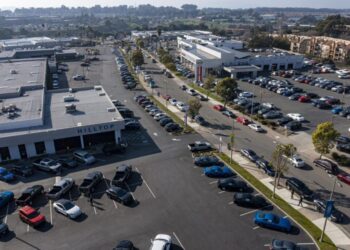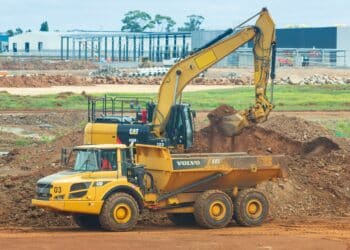Dealer truck orders sink ahead of pending 25% tariff
50% of dealers saw weakened new truck demand in Q3
President Donald Trump’s planned 25% tariff on medium- and heavy-duty trucks is affecting dealers in multiple ways, with some scrambling to order more trucks while others operate as usual.
The tariff, set to take effect Nov. 1, applies to trucks weighing more than 10,000 pounds, posing another challenge to a market that’s been grappling with weak demand as the yearslong freight recession continues.
Reflecting weak demand, more than 60% of surveyed truck dealers reported decreased orders year over year in the third quarter, and none reported increased orders, according to heavy-equipment research firm IronAdvisor Insights. About 50% said new truck demand was deteriorating, and less than 15% said demand was improving.
Some dealers are ordering hundreds of trucks to avoid potential price hikes due to the new tariff and supply chain disruptions, according to the IronAdvisor report.
However, loading up on inventory could be risky, with some fleet operators stopping all orders following the tariff announcement, a freight company executive stated in the report.
“Orders will get canceled on anything coming in for dealers,” the executive said, adding that the Federal Reserve’s quarter-point interest rate cut in September “won’t help with new trucks anymore. … Trump just hampered the entire trucking industry.”
For other dealers, tariffs are hardly being discussed with customers, Peter Spitzer, commercial and fleet account manager at DuPratt Ford Dixon, said last week during the Commercial Vehicle Business Summit.
“It’s almost a moot point at this point,” he said. “They’re going to look at what payment we have to offer them compared to other brands. … They’re going to do their own research on reliability, capability and affordability. They’re going to see how it’s going to impact their business.”
There’s also hope that foreign OEMs will be able to negotiate carve-outs with the Trump administration, exempting some products from tariffs in exchange for domestic production promises, according to IronAdvisor.
Navigating price hikes
The average price of a new truck was $194,950 as of Oct. 6, up 16.2% month over month, according to Equipment Finance News’ Average Truck Price Trends data.
While some tariff-driven price increases are inevitable, dealers can help customers find creative ways to lower operating costs, Spitzer said.
“Everyone knows prices are going up, but that’s why we have the conversation with our customers about their expenses for their business,” he said. “Can we sell them a maintenance plan and save them money that way, by locking in today’s rates and buying their maintenance packages in Costco bulk?”
Integrating telematics in a new vehicle can also lower insurance costs by enhancing visibility of its performance and condition, lowering the risk for insurance providers, Spitzer said.
In addition, lenders and dealers should focus on “outcome selling” amid rising new truck prices, Kirk Mann, executive vice president and head of transportation at Mitsubishi HC Capital America, said during the event.
“We have to be able to convince the operators of this equipment that the outcome will either be the same or better,” he said. “And in most cases, if you’re replacing your existing fleet with new equipment, you’re going to come out better because of the efficiencies.”
Register here for the free Equipment Finance News webinar “High-priced used equipment inventory: The no-man’s land of equipment finance” set for Tuesday, Oct. 21, at 11 a.m. ET.









